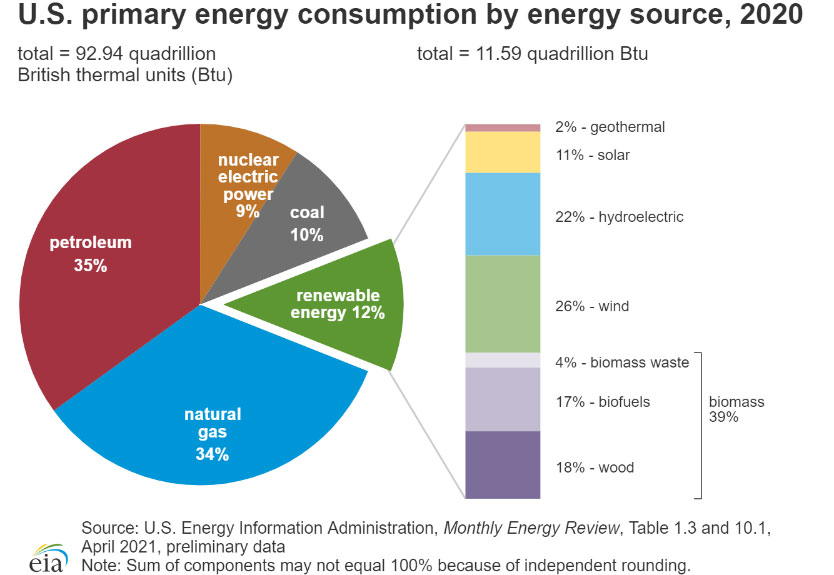The energy beneath our feet: highlighting the future of geothermal electricity generation
There is an increased global focus on reducing greenhouse gas emissions. To aid in this initiative, the energy sector continues to invest in infrastructure for renewable energy power sources to generate electricity. Currently, geothermal power makes up a small percentage of the overall energy consumption by energy source in the US as shown in Figure 1.

Figure 1: US primary energy consumption by energy source, 2020(2)
The nation is focused on increasing its renewable energy portfolio and generating capacity while investing in clean energy programs and projects. Electricity produced from geothermal energy will play a major part in the future of renewables. The US legislation allocates over $500 million for projects that demonstrate one or more clean energy technologies, including geothermal. Energy producers and the public will benefit from this government incentive for power plant infrastructure and technologies for geothermal projects. There are numerous advantages to geothermal energy, including:
- Huge potential of available renewable energy
- Reliable and sustainable
- Non-polluting environmentally friendly
- Unlike solar and wind energy, geothermal energy is not dependent on current weather conditions
- No fuel required
Electrifying Site
As is the case with most, if not all, renewable power sources, location and site conditions are a key factor in determining viability and profitability of the potential energy source. Choosing a geothermal plant site location is a hot topic – literally. The temperature gradient and reservoir characteristics define the process and commercial parameters3. Some areas of the earth’s surface are relatively close to high temperature reservoirs and, with advances in drilling and subsurface fracturing technologies, more heat reservoirs are becoming accessible for geothermal power operations.
Advances in technology creates more options for electrical producers. An enhanced geothermal system (EGS) is a developing technological approach for capturing heat in dry subsurface areas. EGS utilizes deep drilling and fracturing technologies to create a subsurface heat exchanger. After drilling to depth, high-pressure fluid is pumped into the reservoir to break up the rock matrix, which increases permeability and fluid flow characteristics. Geothermal power plants then pump water into the fractured rock where it’s heated by the hot rock. The hot water returns to the surface as steam and is used to power turbines to generate electricity.
Fluid Solutions
For most areas of the US, where high-temperature reservoirs are currently unavailable, electricity producers have the option of completing a binary cycle power plant. Binary cycle geothermal power generation plants typically utilize moderately heated geothermal fluid (brine) and a secondary fluid (typically propane, butane, or pentane) with a much lower boiling point4. Binary cycle power plants operate in a closed-loop cycle, which means that virtually no greenhouse gases are emitted into the atmosphere.
The cost for electricity produced by geothermal facilities must also be compared to new combined cycle plants. The US Energy Information Administration forecasts the total installed cost for geothermal plants coming online in 2026 will be comparable with new combined cycle power plant entering service.5
Future is Now
Electricity producers will be utilizing geothermal source heat as a reliable means of power generation and, with new government incentives combined with advances in technology, proper planning, and project engagement, the geothermal sector can expect significant growth in the very near future.
The energy sector will soon see more geothermal power plants in development and construction phases. Hatch is currently working with geothermal energy producers in California and racing to put these facilities online. One example is the Hell’s Kitchen Geothermal Integrated Lithium and Power Project, which involves the development of a high-temperature flash steam geothermal power plant that will integrate into a lithium extraction facility. The lithium produced can be sourced for use in lithium-based batteries for electric vehicles. Hatch has an experienced and diverse team that combines vast engineering and business knowledge to support geothermal power developments. Please contact us if you are implementing or considering similar projects.
References
1 House of Representatives (H.R. 3684) entitled “An act to authorize funds for Federal-aid highways, highway safety programs and transit programs, and for other purposes.”
2 U.S. Energy Information Administration, Monthly Energy Review, Table 1.3 and 10.1, April 2021, preliminary data
3 National Renewable Energy Laboratory (NREL), maps, Geothermal Prospector, Estimated Temperature at Depth 2000 m, accessed October 26, 2021, maps.nrel.gov/geothermal-prospector
4 Office of Energy Efficiency & Renewable Energy, Electricity Generation, accessed October 26, 2021, energy.gov/eere/geothermal/electricity-generation
5 U.S. Energy Information Administration, Levelized Costs of New Generation Resources in the Annual Energy Outlook 2021, February 2021

Michael Seidlich
Mechanical Engineer, Thermal Power
Michael Seidlich has a multifaceted background in engineering, energy, and construction. He has extensive experience in the power, petrochemical, phosphate, metals, and mining industries. Michael routinely supports mechanical equipment design engineering, equipment evaluations, power system design and the delivery of projects.